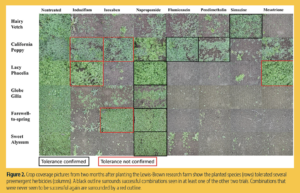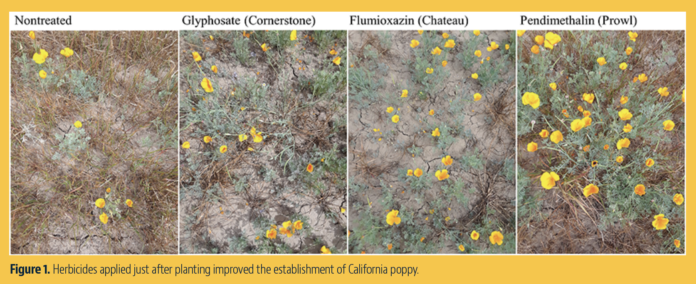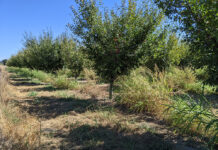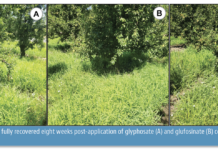Pollinator health has been a concern for many growers in the western U.S. in recent years. Pollinator insects are essential to produce many economically and nutritionally important crops grown in this region. These crops include blueberries, almonds, sunflowers, cucurbits and many others. Notably, almond pollination in California plays a vital role in the apiary industry, driving beekeepers to haul huge numbers of bee colonies to California for the few weeks in early spring when almonds bloom. Bees are selective of the pollen and nectar they forage, and diverse floral resources can allow bees to forage according to their nutritional needs. As pollinator health has grown as a concern, managing farmlands to promote pollinator health is often a goal for many land managers.
A common practice in many California orchards is to allow resident vegetation (weeds) to grow in row middles. This can reduce soil compaction and erosion, and sometimes, these resident weeds can also provide habitat for pollinators (if not mowed). However, these weedy species are often not of high nutritional quality for hungry pollinators, and species composition varies widely. As weedy species set seed, they can become a weed management headache. Resident weeds are resident for a reason, and it is often wise to keep them closely mowed to discourage seed production. An alternate option is to manage non-crop vegetation actively.
Active management of non-crop vegetation can involve cover cropping, conservation hedgerow plantings in field margins and establishing wildflower meadows in regions adjacent to crop fields. For any of these options, species selection and weed management are two of the most important factors affecting success. Small-seeded wildflower species are especially sensitive to competition from annual and perennial weeds. This article summarizes our research on the interaction of weed control methods and species selection in fall-seeded pollinator habitats.
Locations and Treatments
Three locations in Oregon’s Willamette Valley were selected for studies. Two were drip-irrigated hazelnut orchards, and one was a field with sprinkler irrigation. Each location received different soil preparation. The first orchard location (Corvallis) was not tilled, and soil compaction was an issue. The second orchard location (Amity) was power-harrowed, so the top two inches of soil were loosened. The third location (Lewis-Brown Research Farm) was plowed and disked.
All three locations were seeded in the fall with a set of flowering species with potential for pollinator habitat. These included hairy vetch (Vicia villosa) at 60 lb/A; lacy phacelia (Phacelia tanacetifolia) at 12 lb/A; California poppy (Eschscholzia californica) at 8 lb/A; and farewell-to-spring (Clarkia amoena), globe gilia (Gilia capitata) and sweet alyssum (Lobularia maritima) at 2 lb/A.

These species were planted in rows, and herbicide treatments were applied over the top perpendicular to planting rows (Table 1). Four herbicides were applied after crop emergence, and the rest were applied one day after planting. Glyphosate treatments were only included in the orchard trials, and all other herbicides were selected because they exhibit some level of soil residual activity. Experimental plots were replicated four times at each location, and each species was treated as a separate experiment. A crop oil concentrate at 1% v/v was included for Motif (mesotrione) and Basagran (bentazon), while a nonionic surfactant at 0.25% was included for Matrix (rimsulfuron) and Quinstar 4L (quinclorac). All post-emergent treatments (and glyphosate) included ammonium sulfate equivalent to 8.5 lb/100 gal.
In Amity, competition from perennial grasses resulted in inconsistent stand establishment. A grass-selective herbicide (clethodim) was used, and the site was reseeded six months after the initial planting when soil conditions were appropriate.
Site Differences
Drastic differences were seen between sites. Crop coverage at the Corvallis site was below 28% for all species except hairy vetch, which had 89% coverage. Winter annual weeds can compete very strongly with fall-seeded wildflowers, so some of our untreated control plots were devoid of the planted species.
Several species did well at the Amity location. Phacelia in the glyphosate plots had the best establishment at this site (81% coverage) due to glyphosate’s good control of perennial grasses that were not killed by the power harrow. Phacelia is also very competitive with annual weeds, so preemergent treatments were unnecessary. One drawback of phacelia is that it can out-compete other planted species when included in cover crops or wildflower mixes.
Lewis-Brown (LB) plots initially had the best crop establishment (75% to 100% coverage for all species) due to more extensive site preparation. However, this location had intense pressure from perennial weeds, so our good initial crop establishment did not translate to a long-term pollinator habitat. The plots at LB where indaziflam (Alion) was applied produced a good stand of Canada thistle (Cirsium arvense) by the end of the trial, which the bees loved.
Treatments Applied After Crop Emergence
Treatments at this application timing were challenging to evaluate for crop safety. Weed control efficacy was inadequate. So, crop establishment was often not good enough to assess crop injury confidently.
One exception was hairy vetch. This species exhibited good tolerance to a post-emergent application of bentazon, a result seen at all three locations. The results from two trials also suggest farewell-to-spring tolerated post applications of quinclorac. Not enough data were collected to reach conclusions for the other four species.
Treatments Applied Prior to Crop Emergence
Preemergent herbicides often had inconsistent crop safety; however, several combinations seemed safe. Napropamide was safe for use with lacy phacelia, globe gilia, farewell-to-spring and sweet alyssum, while flumioxazin and pendimethalin were safe with poppy (Fig. 1). All five species only had adequate crop establishment at two of the three locations. Hairy vetch establishment was improved by simazine applications at all three locations, but crop coverage was not significantly different from the untreated control for this species. Hairy vetch was the only species where it seemed herbicide treatments or tillage added little benefit to its competitiveness. Figure 2 shows the treatment by species combinations that were sometimes safe versus the combinations that were consistently safe for the planted species.

The glyphosate application improved gilia, phacelia and poppy establishment. For phacelia, glyphosate was by far the best treatment, while for gilia and poppy, glyphosate was of similar efficacy as the non-injurious preemergent treatments (napropamide for gilia and flumioxazin/pendimethalin for poppy).
All three trials were conducted on fine soils with organic matter content ranging from 2% to 7% (USDA-NCSS soil survey, websoilsurvey.sc.egov.usda.gov/). The safety of preemergent herbicides for pollinator species establishment may vary depending on soil characteristics.
This research broadly demonstrates something likely well understood already: that weed control prior to planting (whether through tillage or herbicide) should not be skipped. Pollinator habitat is not something that is usually intensively managed, and it can be tempting to cut costs. I have seen too often when corners are cut at establishment, you can end up exactly where you started: with a field full of weeds (and a monetary loss for the time and herbicides invested).
Soil compaction and perennial weeds must be addressed to have a successful pollinator habitat planting. Our research also shows certain preemergent herbicides can improve habitat establishment, but crop safety must be adequately established. This is especially true of different soil types and environments. In California’s Central Valley, pendimethalin has been seen to occasionally cause injury in poppy plantings, which is in contrast with this study. This may be due to different soil characteristics affecting toxicity to the emerging seedlings. Preemergent herbicides like pendimethalin can also be used at a delayed preemergent timing, waiting until just after seedlings emerge to apply the herbicide. This is possible only if the herbicide has no post-emergent activity on the treated crop.
Lastly, be careful using herbicides around pollinator habitats to protect the pollinator species from injury. Herbicides and surfactants can be toxic to insects and should not be used near flowering plants while bees are active.




















